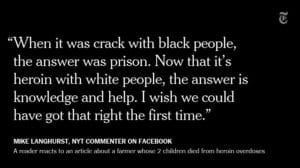CBC podcasts: Smartphones & badly-behaved students; Christianity & capitalism; Woodrow Wilson, John A. Macdonald, & racism

The image – click on it to enlarge it – is from a March 18, 2017 tweet from The New York Times @nytimes reading: Our top 10 comments of the week http://nyti.ms/2nD8BJX
I enjoy the CBC.
I’ve been highly impressed with the following November 2015 CBC The Current podcasts:
Christianity & capitalism:
God bless America: How Christ became central to capitalism and US politics
Woodrow Wilson, John A. Macdonald, & racism:
Calling out the racist legacy of Woodrow Wilson and other historical figures
Smartphones & badly-behaved students:
Toronto teacher blames smartphones for her badly-behaved students
Updates
A May 25, 2016 Guardian longread article is entitled: “The enduring whiteness of the American media: What three decades in journalism has taught me about the persistence of racism in the US.”
Also of relevance is a book I learned about from a New York Times article, namely Hitler’s American Model: The United States and the Making of Nazi Race Law (2017).
Summary
How American race law provided a blueprint for Nazi Germany
Nazism triumphed in Germany during the high era of Jim Crow laws in the United States. Did the American regime of racial oppression in any way inspire the Nazis? The unsettling answer is yes. In Hitler’s American Model, James Whitman presents a detailed investigation of the American impact on the notorious Nuremberg Laws, the centerpiece anti-Jewish legislation of the Nazi regime. Contrary to those who have insisted that there was no meaningful connection between American and German racial repression, Whitman demonstrates that the Nazis took a real, sustained, significant, and revealing interest in American race policies.
As Whitman shows, the Nuremberg Laws were crafted in an atmosphere of considerable attention to the precedents American race laws had to offer. German praise for American practices, already found in Hitler’s Mein Kampf, was continuous throughout the early 1930s, and the most radical Nazi lawyers were eager advocates of the use of American models. But while Jim Crow segregation was one aspect of American law that appealed to Nazi radicals, it was not the most consequential one. Rather, both American citizenship and antimiscegenation laws proved directly relevant to the two principal Nuremberg Laws–the Citizenship Law and the Blood Law. Whitman looks at the ultimate, ugly irony that when Nazis rejected American practices, it was sometimes not because they found them too enlightened, but too harsh.
Indelibly linking American race laws to the shaping of Nazi policies in Germany, Hitler’s American Model upends understandings of America’s influence on racist practices in the wider world.

Leave a Reply
Want to join the discussion?Feel free to contribute!